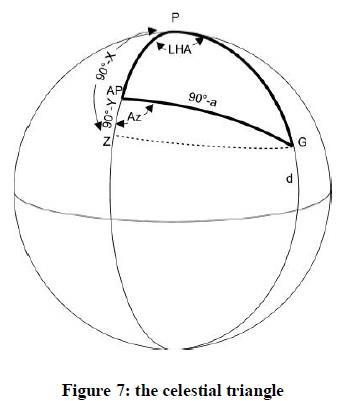
NavList:
A Community Devoted to the Preservation and Practice of Celestial Navigation and Other Methods of Traditional Wayfinding
From: Bob Goethe
Date: 2015 Jul 8, 15:07 -0700
Greg,
This PDF was just the sort of thing I was looking for, with a concise statement of the formulae for Bygrave. That said, my first attempt at using the equations came up with nothing like what I got from Pub. 249. I would appreciate you (or perhaps others) helping me sort out where I am making my errors.
First, I recast the equations slightly to make them fit the way my mind works.
tan(x) = tan(d) ÷ cos(LHA) I recast as
1. tan(d) ÷ cos(t) = tan(x)
...where d = declination of the GP, and
t = meridian angle
I inserted a line for myself of
2. lat ~ X = Y
...where I am looking for the difference between the latitude of the AP (i.e. "lat") and the latitude of point X. This difference I designate as Y.
3. (tan(t) * cos(X)) ÷ cos(Y) = tan(Az);
I inserted another line:
4. 180 - Az = Z
...where Z is the azimuth angle to the GP (e.g. N 100° W). From that, I can derive Zn, the azimuth (e.g. 260°)
Finally, where Ronald uses "a" in his final equation, I designate that as Hc. Hence:
5. cos(Az) * tan(Y) = tan(Hc);
I *think* I have wrapped my head around the equations...except that I come up with answers that don't match with Pub. 249. So either I have misunderstood the equations, or I am not using my calculator properly.
Here is the scenario I used.
GP of the sun: GHA = 48° 03.6' Declination = N 11° 44.6'
AP = 53° N 114° 03.6' W
Hence, the meridian angle = t = 66°
1. tan(11.743°) ÷ cos(66°) = tan(X)
0.208 ÷ 0.407 = 0.511
X = arctan(0.511) = 27.1°
2. 53° ~ 27.1° = Y
Y = 25.9°
3. (tan(66°) * cos(27.1°)) ÷ cos(25.9°) = tan(Az);
(2.25 * 0.890) ÷ 0.899 = tan(Az)
2.00 ÷ .899 = 2.22
Az = arctan(2.22) = 65.8°
4. 180 - 65.8 = Z
Z = N 114° E
5. cos(65.8°) * tan(25.9°) = tan(Hc);
0.410 * 0.485 = 0.199
arctan(0.199) = 11.2°
Now, when I do this with Pub. 249, I get an azimuth angle "Z" of N 103° E and an Hc of 23° 44'.
Clearly, I am doing some things very wrong. Do you observe what they might be?
Thank you for giving thought to this.
Bob







